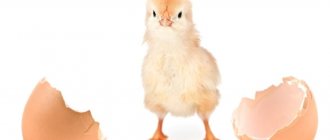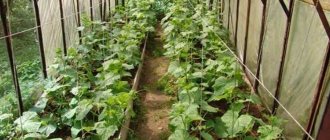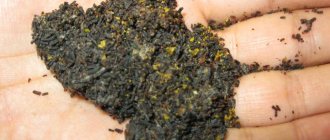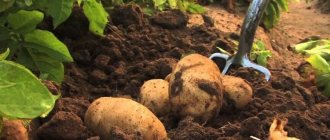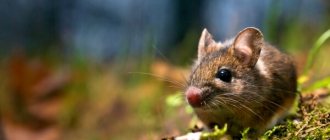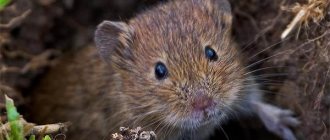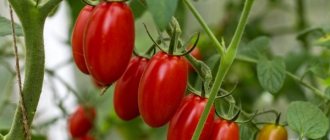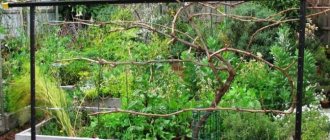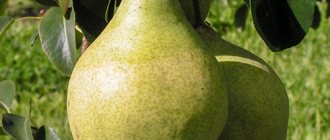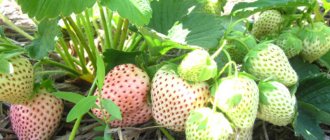The Shchedrik cucumber is an early-ripening hybrid for greenhouses and vegetable gardens. The crop is grown for personal consumption and mass sale. The plant is unpretentious in care - it only needs timely watering and fertilizing with fertilizers.
Zelentsy are not prone to overgrowth and do not accumulate bitter substances. The dense pulp without voids allows them to be pickled and salted for the winter.
In this material we have prepared information about the principles of hybrid agricultural technology, its advantages and disadvantages.
Description of the variety
An early-ripening hybrid of parthenocarpic pollination type, it is characterized by universal use and high disease resistance. Cucumber bushes “Shchedrik f1” are vigorous, with an average level of climbing, heavily leafy, with a female type of flowering and the formation of 2-3 ovaries at the nodes. The fruiting phase occurs on the 47th day from emergence.
The fruits are from 10 to 12 cm long, with a tuberculate and white-thorned surface, cylindrical in shape, with a cross-sectional diameter of 3.7 cm. The average weight of the fruit is 98 g . The pulp is of good density, without bitterness, covered with aromatic and delicate skin.
The total yield of the plant, depending on the cultivation conditions, can vary from 5.5 to 7.0 kg. The fruits are characterized by excellent keeping quality and can be transported over long distances without loss of commercial value and taste.
Harvesting and application
The first harvest begins approximately 45 days after emergence .
Up to 6 kg of cucumbers are harvested from one bush. Experts recommend harvesting continuously - this promotes abundant fruiting. The fruits have dense pulp with a small number of seeds . Thanks to the efforts of biologists, they do not taste bitter, and voids do not form inside. Dense and crispy cucumbers are suitable for pickling, pickling, preparing lightly salted snacks and fresh vegetable salads.
The harvest is stored in a cool place for up to three weeks without loss of taste and marketability. It tolerates transportation well over long distances.
Advantages and disadvantages
The main advantages of the promising hybrid form “Shchedrik f1” are confirmed by the presence of the following characteristics:
- has good keeping quality;
- has a high level of transportability;
- resistance to powdery mildew, true and downy, olive spot, root rot and TMV;
- excellent taste and appearance of the fruit;
- Both open and closed soil are suitable for cultivation;
- high yield of marketable fruits at a level of at least 12.8 kg per square meter of plantings of this vegetable crop;
- suitability for implementation and versatility of application.
The fruits of this hybrid form never taste bitter. They are simply not able to accumulate the bittering substances cucurbitacin, even under very unfavorable growing conditions. Also, this hybrid produces fruits without pollination, which increases the yield level in any conditions.
Diseases and pests
Cucumber Shchedrik F1 is resistant to most diseases characteristic of this vegetable crop. These are powdery mildew, olive spot, tobacco mosaic, root rot. However, gardeners recommend treating the bushes with fungicides for preventive purposes before fruiting begins.
Among the pests that threaten cucumbers, it is worth noting spider mites, aphids, and thrips. Plants need to be inspected regularly. At the initial stage of the lesion, you can get by with traditional methods, namely treatment with a soap solution or infusion of wood ash. If pests spread, you will have to resort to chemicals.
You can learn more about the Shchedrik cucumber variety from the video.
Growing from seeds
Hybrid "Shchedrik f1" is intended for cultivation in open and protected ground. It is possible to sow seeds on ridges in the last ten days of May subject to the following conditions:
- it is preferable to use ridges with breathable and medium-loamy soils, which are fertilized with basic nutrients in the fall;
- It is very important to enrich the soil in which you plan to grow cucumbers with organic matter in advance and add high-quality compost or mature manure;
- It is recommended to sow seeds in soil heated to at least 16-18 ° C, which will guarantee a high percentage of germination;
- when carrying out row sowing, a distance between seeds of 10 cm and a distance between rows of at least 60 cm should be maintained;
- when carrying out nest sowing, a 50x70 cm pattern is used, with seeds buried from 2 to 3 cm;
- vegetable crops such as cabbage, potatoes, legumes, peppers, tomatoes and onions can act as predecessors of cucumbers;
Before sowing, the seeds should be subjected to proper pre-sowing treatment, which will allow the rejection of all defective and non-germinating seeds, and will also contribute to the production of more friendly and earlier seedlings. Crops should be protected from low temperatures with any covering material.
Diseases and parasites
Despite the variety’s strong immunity to many diseases, if improperly cared for, Shchedrik f1 is susceptible to Alternaria blight. In addition, cucumbers are not immune to pests: aphids and spider mites. We suggest studying the description of diseases and ways to combat them.
Alternaria blight
Alternaria blight, or dry spot, is a disease that affects crops, usually when grown in greenhouses. With Alternaria blight, cucumber yields are significantly reduced. Dry spotting is characterized by the following symptoms:
- The leaves of the plant are covered with small spots that are pale yellow in color;
- After a while, dark brown turf appears on the surface of the leaves;
- Afterwards, the foliage of the plant dies and falls away.
To prevent the development of cucumber disease, experts recommend treating cucumbers with the chemicals Quadris, Bravo, or Polyram.
Aphid
Aphids are small pests that can destroy a crop in just a few days. As a rule, melon aphids are found on cucumbers. When a pest invades, sticky droplets appear on the above-ground part of the Shchedrik bush, the leaves change their shape, begin to curl and wither. In addition, flowers fall off and a significant number of ants appear in the beds. To get rid of a small pest, you need to use the chemicals “Aktara”, “Iskra-Bio”, “Karbofos”, or “Tanrek”.
Spider mite
Spider mites are a pest, after the appearance of which the tops of the plant stop developing and begin to dry out, and cucumbers stop forming, or deformation of the shape of the greens is observed. The main signs of the appearance of a spider mite are considered to be the cessation of development of the bush variety, the formation of small white dots on the bottom of the leaves, and the formation of a white cobweb on the leaves and stems of the plant. To get rid of the pest, the bushes are treated with Actellik, Apollo, Neoron, Karbofos, or Anti-mite substances.
Seedling planting method
Despite the fact that the Shchedrik f1 cucumber belongs to the early-fruiting hybrid forms, for regions with a cool climate it is recommended to use the seedling method of cultivation:
- before sowing seedlings, it is necessary to carry out preparatory measures and perform disinfection, heating, hardening and soaking of seeds;
- Before the first shoots appear, it is advisable to cover the seedling boxes with film or glass and keep them at a temperature of 25-28 ° C, trying to maintain soil moisture;
- emerging seedlings must be illuminated, the seedling box should be placed in a bright room with a temperature of 20 °C;
- In order to prepare seedlings for planting in a permanent place, ten-day hardening procedures should be carried out.
The age of cucumber seedlings at the time of planting should be approximately 25-30 days. It is advisable to plant hybrid forms, as well as bush varieties, with seedlings spaced 90 cm apart and with the same spacing between rows.
Hybrid agricultural technology
Hybrid cucumber Shchedrik is grown by seedlings in regions with cool summers and by sowing in the ground in the southern regions. The culture prefers light, fertile, loamy soil.
Plant care includes moderate watering, fertilizing, loosening, weeding and mulching, as well as preventing downy mildew.
Planting through seedlings
Hybrid seeds are not treated before sowing, since the material in packages is sold already disinfected.
To grow healthy and strong seedlings , use soil enriched with organic matter and minerals.
For self-preparation, you will need 1 part sawdust and 2 parts each of humus and peat. For disinfection, the substrate is treated with a dark solution of potassium permanganate or “Fitosporin”. The mixture is prepared in a large bucket and 30 g of ash and 25 g of nitrophoska or superphosphate are added. Seeds are sown immediately in individual cups made of plastic or peat .
The containers are filled with a damp substrate, one grain is placed in holes 2 cm deep and watered generously with water at room temperature. After two leaves appear, the seedlings are taken out to a sunny windowsill and fed with a solution: 45 g of nitrophoska per 3 liters of water. The hybrid is demanding on lighting, so if there is a lack of sunlight, seedlings are helped with fluorescent lamps. The duration of daylight should be at least 15 hours.
Seedlings are watered generously once a week . 10 days before planting, it is taken out into fresh air for hardening, gradually increasing the time from 20 minutes to 24 hours.
After 25–30 days, the seedlings are transferred to the ground . Holes 5 cm deep are dug in the area and plants are planted at intervals of 50–70 cm.
Other varieties of self-pollinating cucumbers:
Early ripening Murashka cucumber that does not require pollination
Hybrid cucumber “Grandma’s granddaughter f1”: description and features
Growing by seed
Cucumbers are a heat-loving crop, so before direct sowing, it is advisable to make sure that the soil has warmed to +16 °C and the air to +23 °C. Sowing activities are carried out in the last days of May.
The soil is prepared in the fall : dug up, disinfected with copper sulfate (1 tsp per 3 liters of water) and fed with humus (10 liters per 1 m²). In the spring, they dig it up again, add humus, peat and wood ash in a ratio of 1:1:1.
Direct sowing is done in two ways:
- Row sowing . Seeds are planted with their nose down, 2 pieces each. in each hole 3 cm deep, at a distance of 10 cm. The gap between the rows is 60 cm.
- Nest sowing . The holes are placed at a distance of 60-70 cm. Depth - 7-10 cm, diameter - 8-10 cm. 7-10 seeds are placed in each hole and subsequently 5-6 strong sprouts are left.
After sowing, the soil is mulched with peat and generously moistened with warm rain or settled water. To protect against night frosts, the area is covered with agrofibre.
Important! To grow cucumbers, choose areas where zucchini, cabbage, onions, beans, and peas previously grew.
cucumbers with and without mulch, the difference is obvious!
Cultivation rules
The success of growing the Shchedrik hybrid and its productivity depend on compliance with the rules of care:
- Plants are watered after sunset with warm, settled water 1-2 times a week.
- After each watering, the soil is loosened and weeds are removed.
- To reduce the frequency of weeding, the soil is mulched with peat, sawdust, hay or black agrofibre.
- Organic and mineral compounds are used as fertilizers.
- After planting (sowing), double treatment with fungicides is carried out to prevent fungal and bacterial infections.
- To improve the ventilation of plantings and facilitate plant care and harvesting, the lashes are tied to trellises.
Scheme for fertilizing cucumbers:
- the first - two weeks after planting (sowing);
- the second - from the moment of flowering;
- the third - during the fruiting period;
- fourth (optional) - to extend the fruiting period and increase the volume of the harvest.
First feeding option:
- organics – chicken manure solution 1:15;
- minerals - 10 g superphosphate, 10 g urea, 10 g potassium salt per 10 liters of water.
Second feeding option:
- organics – horse manure solution 1:8;
- minerals - 5 g of ammophoska (sprinkle the beds and seal them by loosening).
Option for the third feeding:
- organic matter – solution of green fertilizers (infusion of tops, mown grass) 1:5;
- minerals - 50 g of urea per 10 liters of water.
Option of the fourth feeding:
- infusion of rotted hay;
- 1 glass of wood ash per 10 liters of water;
- 25 g of soda per 10 liters of water.
Reference. An infusion of ash can be added every 10 days until fruiting stops.
Nuances of cultivation and possible difficulties
Hybrid Shchedrik f1 painfully tolerates stuffiness in the greenhouse , so to create an optimal microclimate in the heat, the room is regularly ventilated.
Excess moisture has a detrimental effect on the root system and leads to rotting. The plant tolerates a lack of water more easily than its excess.
Bushes are prone to wilting and shedding green mass if planted in a draft. To protect cucumbers from gusty winds, tall crops (corn, sunflower) are sown next to the plantings. The canopy crops form a protective wall, behind which the cucumbers feel comfortable and enter the fruiting period 4–6 days earlier.
Advice. Sow trailing plants 1-1.5 weeks before sowing cucumbers.
Diseases and pests
Hybrid Shchedrik is resistant to major cucumber diseases , but is prone to downy mildew (downy mildew).
Signs of the disease:
- small brown or yellow spots on the front side of the leaves;
- gray-violet coating on the back side;
- the leaves become yellow-brown and dry out.
Causes:
- increased air humidity and air temperature below +9 °C;
- excessive watering with cold water;
- increased level of alkali in the soil.
Prevention:
- digging up the soil and disinfecting with copper sulfate, potassium permanganate, “Gamair”, “Fitosporin”;
- removal of infected bushes followed by burning;
- weeding and loosening beds;
- compliance with the principle of crop rotation.
Treatment:
- treatment with chemicals at an early stage: 0.5% solution of Bordeaux mixture, Ridomil, Oxykhoma;
- folk remedies based on ash, potassium permanganate, milk and iodine.
Recipes for folk remedies for downy mildew:
- 10 drops of iodine per 1 liter of low-fat milk, bring the volume to 10 liters. The solution is used to irrigate bushes once every 7-10 days.
- 400 g of ash per 750 ml of boiling water, leave for 3-4 hours and filter through cheesecloth. Bring the volume to 10 liters and spray the bushes once a week.
- 1 g of potassium permanganate per 10 liters of water. The solution is used to treat plants twice a month.
To get rid of insect pests (melon aphids, spider mites, mole crickets), chemical agents are used: “Fitoverm”, “Aktofit”, “Commander”, “Aktara”, “Nemabaktin”, “Grom”.
Helps fight slugs:
- traps made of beer cans (the smell of the drink attracts the pest);
- night spraying with ammonia solution (4 tablespoons per 10 liters of water);
- tobacco dust, rosemary, ground hot pepper, scattered on the beds.
Rules of care
Cucumber “Shchedrik f1” is capable of increasing productivity if agricultural practices are followed. The technology for growing this hybrid is standard and includes a whole range of activities:
- watering the plants after the heat of the day has subsided with water warmed in the sun;
- fertilizing using organic matter and mineral fertilizers, the application of which should preferably be alternated;
- carrying out double treatment of plants with modern fungicides in order to prevent damage by pathogenic microorganisms and fungal infections;
- tying the vines to a trellis, which will improve ventilation of the plant, facilitate uniform ripening of fruits and make care less labor-intensive;
- ridges should be weeded regularly, and systematic shallow loosening of the soil should be carried out.
High temperatures inside the greenhouse space or under film cover can negatively affect the quality of the fruits, as well as provoke a significant increase in the number of male flowers. Therefore, on particularly hot days, it is recommended to shade the plants and maintain ventilation.
Reviews
Feedback from farmers about growing the Shchedrik hybrid is mostly positive.
Larisa, Kursk : “I grow hybrid cucumbers only in a greenhouse. Among them is Shchedrik from Gavrish. I switched to the products of this company a long time ago and am satisfied. Cucumbers are absolutely undemanding to care for. With little labor input, they allow you to get a rich harvest. They bear fruit continuously until the end of September.”
Igor, Podolsk : “I have been planting cucumbers for several years in a row, seed germination reaches 100%. I grow it from seedlings in a greenhouse. I do not treat the seeds with anything. I tie the bushes to a trellis, but do not shape them. Caring for the plant is easy. I water deeply once a week. In the summer I ventilate the greenhouse.”
Varvara, Gukovo : “I grow the Shchedrik hybrid, along with other varieties of cucumbers, in the garden using direct sowing in the ground in early June. I cover the top with agrofibre overnight. The shoots are friendly, the fruiting is abundant. Greens are not prone to overgrowing. The pulp is dense, juicy, without bitterness.”
Cucumber Shchedrik F1
Shchedrik F1 cucumber is very popular. The fruits of this hybrid can be consumed not only raw, but also canned.
History of variety selection
The Shchedrik cucumber variety was bred by specialists from the Gavrish company. This is an early ripening hybrid, suitable for cultivation both in small quantities and for mass sale. The crop is listed in the Russian register as a variety suitable for planting in private plots.
Description of Shchedrik cucumbers
An adult cucumber bush Shchedrik F1 is quite tall, has a developed root system and many medium-sized green leaves. At least three ovaries are formed in each node. The first fruits are formed approximately 1.5 months after the sprouts appear.
Description of fruits
One plant can produce up to 7 kg of dark green, cylindrical fruits. The pulp of cucumbers does not contain a large number of seeds.
The fully ripened Shchedrik F1 fruit has the following characteristics:
- length – about 10 cm;
- diameter – 3-3.7 cm;
- average weight – 95-100 g.
Vegetables lack thorns and have a bumpy surface. Experts describe cucumbers of the Shchedrik variety as thin-skinned fruits without a bitter taste, with dense pulp.
Characteristics of the variety
Among the main advantages of the Shchedrik F1 variety is resistance to diseases such as root rot, olive spot and powdery mildew. Cucumbers have a pleasant taste and are suitable for canning. The fruits of this variety are subject to long-term storage and are insensitive to transportation over long distances.
Productivity and fruiting
The maximum number of ovaries formed in the nodes is two or three. The first harvest can be harvested 47-50 days after the shoots appear. The yield of Shchedrik cucumbers from one bush is 5.5-7 kg.
Application area
The hybrid is used for growing both in open ground and in a greenhouse. It has proven itself well on medium loamy soil, previously enriched with organic matter. The cucumber variety Shchedrik F1 is suitable for cultivation in summer cottages and large farms.
Resistance to diseases and pests
For preventive purposes, cucumbers of the Shchedrik F1 variety are treated twice with fungicides such as Quadris or Kuproksat. This prevents plants from becoming infected with fungal diseases and protects them from harmful microorganisms.
Advantages and disadvantages of the variety
The main advantage of this variety is its ability to take root, grow and bear fruit in any weather conditions.
According to reviews of the Shchedrik F1 cucumber, its only drawback is a feature that appears on hot days: under the influence of high temperatures, the plant’s flowers degenerate into the male type.
Features of planting and care
In order for cucumbers of the Shchedrik F1 variety to produce the highest and highest quality harvest, you should pay special attention to the composition of the soil, as well as provide the conditions familiar to this type.
The bed should be well lit and protected from drafts. To plant Shchedrik F1 cucumbers, it is best to use an area where tomatoes, potatoes, beets, onions or cauliflower previously grew. Soil where carrots, pumpkins and late varieties of cabbage were previously grown is absolutely not suitable.
If preparing a bed for planting a hybrid is planned for the fall, the work includes the following steps:
- At the bottom of the holes, the optimal depth of which is from 30 to 45 cm, you need to lay drainage from small twigs, straw and grass.
- Having compacted it well, it is necessary to cover it with a layer of fresh manure and leave it to winter.
To separate empty seeds from the full seed of the Shchedrik F1 variety, they are soaked in salt water (one tablespoon of salt per liter of water) for 15 minutes. The grains that have sunk to the bottom of the vessel are suitable for sowing.
Before planting in the ground, the seed must be disinfected: immerse it in a dark purple solution of potassium permanganate for at least 20 minutes. After disinfection, the seeds are washed in running water and dried before being subjected to the next stage of processing - hardening (for three days, the grains selected for sowing are placed on the bottom shelf of the refrigerator).
At the next stage, the seeds of Shchedrik cucumbers are placed on a wet cloth in a warm place. Over time they should germinate.
They return to the holes in late spring, with the arrival of May. The depressions are filled with fertile soil and covered with polyethylene. After a few days, the seeds are sown; the maximum depth should not exceed 2 cm.
Having previously moistened the soil, 4 or 5 Shchedrik F1 grains are placed in each hole. The first shoots, as a rule, appear after 7-11 days. During the growth period, the beds must be weeded and thinned. Weak sprouts need to be carefully pinched (but under no circumstances pulled out!) so as not to damage stronger seedlings.
Planting seedlings
In cold climates, it is better to grow cucumbers of the Shchedrik F1 variety in greenhouses. The seeds are first placed in separate containers or cups filled with fertile soil.
Sequence of grain preparation:
- Hardening. At this stage, the seeds of the hybrid cucumber variety Shchedrik F1 are kept on the bottom shelf of the refrigerator for three days.
- Soak. After hardening, the seeds are subjected to wet heat treatment, spreading them on a wet cloth and sending them to a warm place for germination.
Sprouted Shchedrik F1 grains are placed in the holes, the depth of which should not exceed 2 cm, and lightly covered with soil. Then the containers are wrapped in film or covered with glass.
Cucumber Shchedrik F1
“Shchedrik” is liked for its high resistance to fungal and infectious diseases, good productivity and ease of care. The variety is self-pollinating, so it grows well in beds and under cover. The seedlings tolerate picking well, immediately begin to grow rapidly, and the harvest is formed in 5-6 weeks. Cucumbers reach a length of 12 cm; gherkins are impossible to obtain. The peel is very dense and protects the fruit well when transported over long distances. The pulp is dense and juicy, the number of seeds is minimal. The bush requires constant care due to the fact that it grows actively and has a large amount of foliage.
In the conditions of the middle zone (Voronezh region), the crop ripens no earlier than 50 days after the appearance of the first shoots. When ripe, the skin acquires a rich dark green color. It is very thin; when consumed fresh, I do not peel it off. The pulp is dense, with small seeds, without voids and bitterness. The harvested crop has good shelf life, and nothing happens to it during long-term transportation. Cucumbers grow well in any conditions, but they begin to yield faster in a greenhouse. Shchedrik is afraid of drafts. Excessively compacted soil negatively affects the development of the root system; it can be affected by rot. You have to constantly loosen and mulch the beds so that oxygen access is always good. The best results during cultivation were achieved on loamy soils. The best green manure crops are tomatoes and onions. I place blades of grass and small twigs in holes 30 cm deep to ensure good drainage. Then I add fresh manure and cover it with soil. You cannot use manure in the spring; it can burn the seeds. When planting, I bury large seeds deeper than small and medium ones.
Since the Shchedrik F1 variety is not bee-pollinated, it can also be grown in greenhouses. But the plants grow very powerful and long, so they definitely need to be tied up. At the same time, they grow better and more evenly and do not rot. Harvesting is much more convenient - all the fruits are in sight, you don’t even need to look for them. It is for this reason that we plant only in open ground. There are no special subtleties in caring for a hybrid. In the same way, we water it with warm water in the evening, feed it with a solution of mullein, bird droppings and ash, remove weeds, and loosen the soil. Less than 2 months pass from the moment the seeds are planted to the appearance of the first cucumbers. The plant is extremely resistant to various diseases and pests, so we do not treat cucumbers with any chemicals. We collect the harvest daily and process it immediately. We eat some immediately, and roll up some. The fruits themselves are small, dense, strong, and juicy. They are good for canning and for eating fresh, in salads, fresh juices, okroshka and other cold soups. Even lightly salted cucumbers turn out tasty and firm. We haven’t tried storing them fresh for a long time; we simply don’t have any left for such experiments.
Review: Cucumber seeds Gavrish “Shchedrik F1” – Amazing variety! The name is completely justified
I planted this variety one of the first, in early spring. Usually at this time I germinate all the seeds in a warm place, on a damp cloth, but I planted these seeds dry in open ground. Soon almost all of them sprouted - hence the first conclusion - the germination of the seeds is good, but this, of course, provided that the expiration date has not expired, it is warm and there is daily watering.
The seedlings grew rapidly in length, the conditions this spring were very favorable, so the first flowers appeared very soon, literally after 6-7 true leaves. By the way, this is a self-pollinating variety from the F1 series, so although not all, the majority (85 percent) of the flowers come out immediately with fruits.
I didn’t tie up these cucumbers (they trudged along the ground), I didn’t particularly care for them, I just watered them with clean water and sometimes diluted manure, but even on my not very good land, the “Shchedrik” cucumbers generously gave me a harvest, which I collected every day or every other day. day.
In terms of taste, juiciness and tenderness, I would classify this variety as one of the best that I am familiar with. Surprisingly, even with poor watering, we never came across bitter fruits; they were always crispy and sweet. Cucumbers grow 13-15 cm in length, then, if not collected, they begin to fill up and get fat. At the same time, the taste does not suffer, and there are no large, coarse seeds inside
That is, it doesn’t matter when to pick cucumbers; when they become overripe, they do not become worse, like many other varieties.
The fruits of this variety are universal in purpose. They are good in fresh salads, in any canned food, or just like that.
In our hot southern summer, it is very difficult to protect planted plants and cucumber foliage also quickly “burns out,” dries out, and turns yellow. But in cucumbers of the “Shchedrik” variety, new shoots constantly appear from the lateral axils of the leaves and at the ends. They bear fruit with renewed vigor until they also dry out, but they are replaced by more and more new shoots. And this would last forever, but, alas, even in our warm region, cold weather sets in in the fall and the cucumbers begin to bear fruit less and less, and then freeze. So they grew into neighboring beds, along paths, into the grass.
To summarize, I will say that I was very pleased with this variety, I will definitely plant it again next year.
Along with Shchedrik cucumbers, I would like to recommend wonderful, unpretentious cucumbers for the lazy.
Preparing the soil and planting site
To grow this variety, it is necessary to select a well-lit area with fertile soil. Areas where onions, potatoes, beets, cauliflower, and tomatoes were grown in previous seasons are suitable for planting.
The selected plot of land should be properly prepared:
- In autumn, the area is cleared of tops and weeds and dug up.
- Make holes or trenches up to 40 cm deep in the garden bed.
- The bottom is covered with dry tops or hay, a layer of manure is laid on top, and everything is covered with earth.
Some summer residents carry out such preparation in the spring. In this case, the manure should be rotted or semi-rotted (1-2 years old). It should be applied at least 3-4 weeks before planting.
Productivity
From one Shchedrik bush they harvest from 5 to 7 kg of greens, which in terms of area is up to 13 kg/sq.m.
REFERENCE: The hybrid is characterized by long-term fruiting (until autumn frosts).
Which regions are best to grow in?
According to registration, “Shchedrik” is suitable for cultivation in the following regions:
- Central;
- Central Chernozem;
- Volgo-Vyatsky;
- Northern;
- Northwestern;
- Middle Volga;
- North Caucasian.
IMPORTANT: For normal growing season, the air temperature should not fall below 13*C, and the soil temperature should not fall below 12*C. This is a decisive factor in choosing where to grow plants: in open ground or in a greenhouse.
Features of cultivation and possible difficulties
The cucumber variety Shchedrik is resistant to diseases. However, improper care of bushes can cause the development of a fungal infection. To cope with the disease, it will be necessary to treat the plantings with a fungicidal agent such as Quadris and Kuproxat.
If the soil moisture regime is incorrectly chosen, the root system may begin to rot. A sharp cold snap, in turn, can lead to wilting and shedding of leaf blades. The ovary does not develop, and the vine dies over time.
Shchedrik bushes often suffer from pest invasions. Plants can be attacked by aphids, white mites or spider mites. To cope with aphids, it is advisable to use a strong tobacco solution. The cucumbers need to be treated with the prepared mixture. To rid cucumbers of mites, you will need to treat the plantings with garlic infusion with the addition of a small amount of antibacterial soap.
A prolonged dry period can negatively affect the appearance of the bushes. The leaf blades will begin to dry out. In this case, it is important to provide the plants with favorable conditions, using not only soil moisture on hot days, but also the sprinkling method.
Description of the hybrid Cedric F1
This cucumber is not yet as widely known as its Dutch “brothers”, but positive reviews have been received from those summer residents who have tried to grow it. Breeders note that it is advisable to plant the plant in greenhouses using the trellis method. In this case, the variety’s yield is higher and its potential is fully realized.
Note! On open ground ridges, cucumbers are often grown spread out, without a garter. More frequent planting is allowed.
The plants are powerful, the growth of the main shoot is not limited by the flower raceme. Belongs to the indeterminate group, branching is average, lateral branches are quickly formed. The type of pollination is parthenocarpic, which greatly simplifies care. It is not necessary to attract bees for pollination, therefore, in temperate climate zones, planting in greenhouses is possible.
It produces predominantly female flowers and has a powerful root system. The leaf blades are bright green, slightly wavy, convex, medium in size. Formation of cucumbers in the axils of 2-4 pieces, a tendency towards a bouquet type is noted.
The fruits are cylindrical, the tubercles are of medium and small height. The skin is evenly colored, the color is emerald green with very small, weakly defined whitish stripes. The pubescence is white, very dense. Cedric is a classic Dutch cucumber with the corresponding type of “shirt”. The spines are located on the tubercles themselves and between them, forming a fairly dense coating.
The main purpose of the fruit is preservation and marinades, but fresh cucumbers are also tasty. The weight of cucumbers does not exceed 110 g, on average - 80-90 g, length - 12-14 cm. The taste characteristics are excellent, the pulp is without voids and bitterness, sweetish, with a pleasant cucumber aroma of freshness. Cucumbers are storable and suitable for transportation. Subject to proper temperature and storage conditions, they can be stored for up to 8-12 days.
Sowing cucumbers
To ensure high yields of the Shchedrik hybrid, attention is paid to the quality of the soil, and also provides the crop with the most familiar conditions for it. The best predecessors are early potatoes, peppers, radishes, peas, and cabbage. If carrots or any pumpkin crop were cultivated in the beds this year, they cannot be used for cucumbers.
Site selection and soil treatment
A sunny area, protected from drafts, with deep groundwater is prepared for vegetable crops. The pH should be neutral or slightly acidic, the soil composition should be rich, and the structure should be loose. Since cucumbers do not tolerate picking well, the seeds are sown immediately in the beds, which are made warm in the fall.

